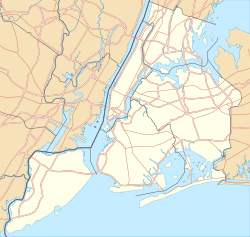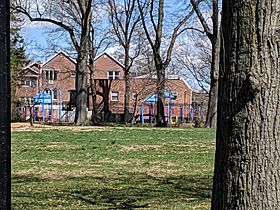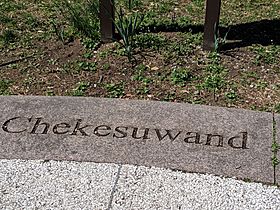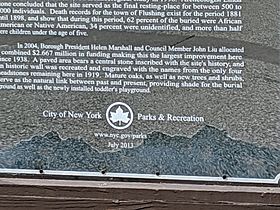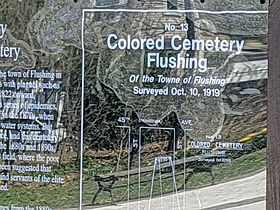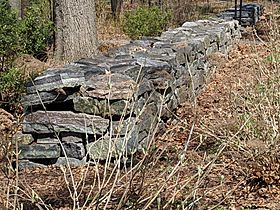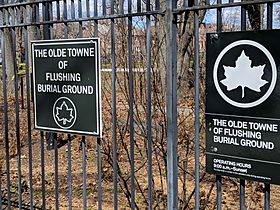Old Town of Flushing Burial Ground facts for kids
Quick facts for kids |
|
|
The Olde Towne of Flushing Burial Ground
|
|
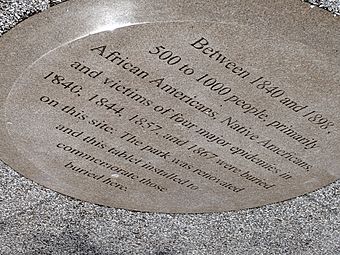
Center stone at Plaza
|
|
| Location | 165th St. and 46th Ave., Flushing, New York |
|---|---|
| Area | 3.5 acres (1.4 ha) |
| Built | 1840 |
| NRHP reference No. | 100002079 |
| Added to NRHP | February 2, 2018 |
The Olde Towne of Flushing Burial Ground is a special historic place in Flushing, Queens, New York City. It is a very old cemetery that was started in 1840. People sometimes called it "Pauper Burial Ground" or "Colored Cemetery of Flushing." It was also known as "Martins Field."
This burial ground was created because of serious sicknesses like Cholera and Smallpox in the 1840s. Town leaders were worried that burying sick people in churchyards would spread diseases. So, they bought this land to create a separate burial spot. Today, it is next to a children's playground called "Martin's Field." In 2018, it was added to the National Register of Historic Places, which means it's an important historical site.
Contents
How the Burial Ground Started
Flushing was once famous for its beautiful gardens and trees. Even George Washington visited the area because of its amazing plants. The burial ground's natural beauty still reminds people of Flushing's history with plants.
Around 1840, Flushing faced a terrible Cholera outbreak. A few years later, in 1844, a Smallpox epidemic hit. People were very scared that burying those who died from these diseases in regular church cemeteries would spread the sickness even more. To prevent this, town leaders bought land from the Bowne family. This land became a separate burial ground for those who died from the epidemics.
By 1854, doctors understood more about how diseases spread. Better hygiene helped stop these outbreaks. Because of this, there was less need for the separate burial ground, and it was not used as much.
A Place for the African American Community
Later in the 1800s, this burial ground became important for the African American community. Newspapers in the 1850s talked about how the AME church was running out of space for burials. From about 1880 until it closed in 1898, the site was mainly used to bury African Americans and Native Americans.
By 1914, the land was used as a public space, like a town park. By 1930, it was paved over and officially became a park called "Martin's Field." In 1936, Robert Moses, who was in charge of New York City's parks, decided to turn the park into a fun place for kids.
Building a Playground
During the WPA period, a new playground was built on the site. The WPA was a program that created jobs during the Great Depression. As workers dug to build the playground, they found evidence that the land had been a burial ground. They discovered human remains, some with old pennies placed over the eyes. This was an old tradition, also seen at the African Burial Ground National Monument in lower Manhattan.
By 1938, the new playground was ready. It had a wading pool, a baseball field, and swings for everyone to enjoy. The WPA's history team interviewed local people to record the site's past as a burial ground. Only grave markers for the Bunn family, who were part of the AME church, remained.
Discoveries from an Archeological Dig
In 1990, a local activist named Mandingo Tshaka helped share the history of the burial ground. This led to an important study in 1996. The Parks Department paid for an archaeological study of the site.
Archeologist Linda Stone found that between 500 and 1000 people were buried there. Records from 1881 to 1898 show that most of the burials (62%) were African American or Native American. Also, more than half of those buried were children under five years old.
The Burial Ground Today
In 2004, leaders in Queens helped get money to make the park better. This was the biggest improvement since 1938. Now, there is a paved area with a special stone that tells the site's history. A historic wall was rebuilt and has names from the only four gravestones that were left in 1919.
Old oak trees and new plants connect the past and present. They provide shade for the burial ground and the playground. The playground was moved to a new spot and built on a special foundation so it would not disturb the ground below. In 2009, the site was officially named "The Olde Towne of Flushing Burial Ground" and "Martin's Field."
In 2018, Mayor Bill de Blasio and community members announced more plans for the site. They set aside money to build a special plaza with a butterfly garden and new benches. Directions will be written in the Lenape language, an old Algonquin language, to honor the Native Americans buried there. A round plaza shows the names of the Manitou's (spirits) of the North, South, East, and West in the Algonquin language. The site is now recognized by New York State and the National Register of Historic Places.
In 2019, artist Alexandria Smith created an art show at the Queens Museum. Her exhibition, called Monuments To An Effigy, helped people remember the women buried at this historic site.
Gallery


